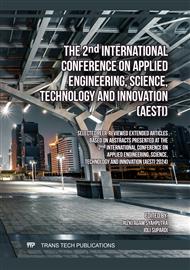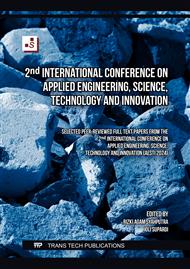[1]
A. Muharma, A. Hasan, and Z. Mizwar, "Faktor Kinerja Sistem Irigasi pada Tiga Daerah Irigasi di Kabupaten Dharmasraya," J. Talenta Sipil, vol. 7, no. 1, p.110, Feb. 2024.
DOI: 10.33087/talentasipil.v7i1.382
Google Scholar
[2]
FAO, "Water for Sustainable Food and Agriculture." 2017. [Online]. Available: https://openknowledge.fao.org/server/api/core/bitstreams/7468fe06-7dd7-4e7a-8f10-bb0084594977/content
Google Scholar
[3]
K. Denner, M. R. Phillips, R. E. Jenkins, and T. Thomas, "A coastal vulnerability and environmental risk assessment of Loughor Estuary, South Wales," Ocean Coast. Manag., vol. 116, p.478–490, Nov. 2015.
DOI: 10.1016/j.ocecoaman.2015.09.002
Google Scholar
[4]
K. Chartzoulakis and M. Bertaki, "Sustainable Water Management in Agriculture under Climate Change," Agric. Agric. Sci. Procedia, vol. 4, p.88–98, 2015.
DOI: 10.1016/j.aaspro.2015.03.011
Google Scholar
[5]
T. Prayogo, S. Wahyuni, and M. Iqbal, "A Study of Irrigation Performance Index and Real Cost Value of Irrigation Operations and Maintenance in Surak Irrigation Area," Civ. Environ. Sci., vol. 004, no. 01, p.030–042, Apr. 2021.
DOI: 10.21776/ub.civense.2021.00401.4
Google Scholar
[6]
I. Hussain and M. A. Hanjra, "Irrigation and poverty alleviation: review of the empirical evidence," Irrig. Drain., vol. 53, no. 1, p.1–15, Mar. 2004.
DOI: 10.1002/ird.114
Google Scholar
[7]
O. Lamhour, I. El Bouazzaoui, D. Perkumiené, L. Safaa, M. Aleinikovas, and M. Škėma, "Groundwater and Tourism: Analysis of Research Topics and Trends," Sustainability, vol. 16, no. 9, p.3723, Apr. 2024.
DOI: 10.3390/su16093723
Google Scholar
[8]
A. S. Abdul-Rahim, C. Sun, and A. W. Noraida, "The Impact of Soil and Water Conservation on Agricultural Economic Growth and Rural Poverty Reduction in China," Sustainability, vol. 10, no. 12, p.4444, Nov. 2018.
DOI: 10.3390/su10124444
Google Scholar
[9]
J. F. Velasco-Muñoz, J. A. Aznar-Sánchez, A. Batlles-delaFuente, and M. D. Fidelibus, "Sustainable Irrigation in Agriculture: An Analysis of Global Research," Water, vol. 11, no. 9, p.1758, Aug. 2019.
DOI: 10.3390/w11091758
Google Scholar
[10]
S. Mutambara, M. B. K. Darkoh, and J. R. Atlhopheng, "A comparative review of water management sustainability challenges in smallholder irrigation schemes in Africa and Asia," Agric. Water Manag., vol. 171, p.63–72, Jun. 2016.
DOI: 10.1016/j.agwat.2016.03.010
Google Scholar
[11]
V. Khandker, V. Gandhi, and N. Johnson, "Gender Perspective in Water Management: The Involvement of Women in Participatory Water Institutions of Eastern India," Water, vol. 12, no. 1, p.196, Jan. 2020.
DOI: 10.3390/w12010196
Google Scholar
[12]
N. Bhattarai et al., "The impact of groundwater depletion on agricultural production in India," Environ. Res. Lett., vol. 16, no. 8, p.085003, Aug. 2021.
DOI: 10.1088/1748-9326/ac10de
Google Scholar
[13]
A. Hamdy, "WATER USE EFFICIENCY IN IRRIGATED AGRICULTURE: AN ANALYTICAL REVIEW".
Google Scholar
[14]
R. Tirtalistyani, M. Murtiningrum, and R. S. Kanwar, "Indonesia Rice Irrigation System: Time for Innovation," Sustainability, vol. 14, no. 19, p.12477, Sep. 2022.
DOI: 10.3390/su141912477
Google Scholar
[15]
P. Drechsel, P. Heffer, H. Magen, R. Mikkelsen, and D. Wichelns, "Managing water and fertilizer for sustainable agricultural intensification," 2015.
Google Scholar
[16]
Z. Karimidastenaei, T. Avellán, M. Sadegh, B. Kløve, and A. T. Haghighi, "Unconventional water resources: Global opportunities and challenges," Sci. Total Environ., vol. 827, p.154429, Jun. 2022.
DOI: 10.1016/j.scitotenv.2022.154429
Google Scholar
[17]
J. E. Fernández, F. Alcon, A. Diaz-Espejo, V. Hernandez-Santana, and M. V. Cuevas, "Water use indicators and economic analysis for on-farm irrigation decision: A case study of a super high density olive tree orchard," Agric. Water Manag., vol. 237, p.106074, Jul. 2020.
DOI: 10.1016/j.agwat.2020.106074
Google Scholar
[18]
Platanus Publishing, "Advances in Agriculture, Forestry and Aquaculture Sciences," Oct. 17, 2023, Zenodo.
Google Scholar
[19]
T. R. Allen et al., "Linking Water Infrastructure, Public Health, and Sea Level Rise: Integrated Assessment of Flood Resilience in Coastal Cities," Public Works Manag. Policy, vol. 24, no. 1, p.110–139, 2018.
DOI: 10.1177/1087724x18798380
Google Scholar
[20]
D. Leroy, "An empirical assessment of the institutional performance of community-based water management in a large-scale irrigation system in southern Mexico," Agric. Water Manag., vol. 276, p.108051, Feb. 2023.
DOI: 10.1016/j.agwat.2022.108051
Google Scholar



